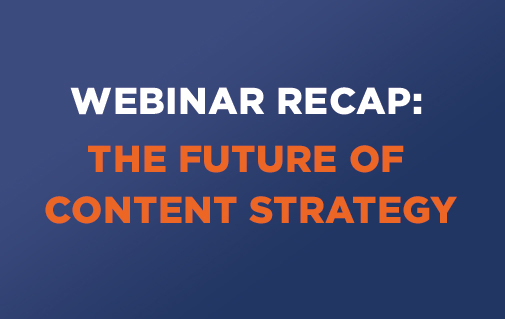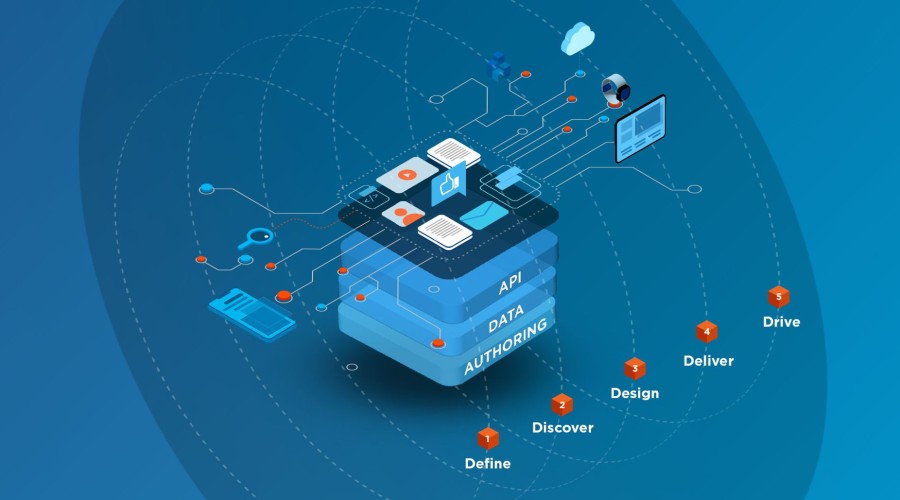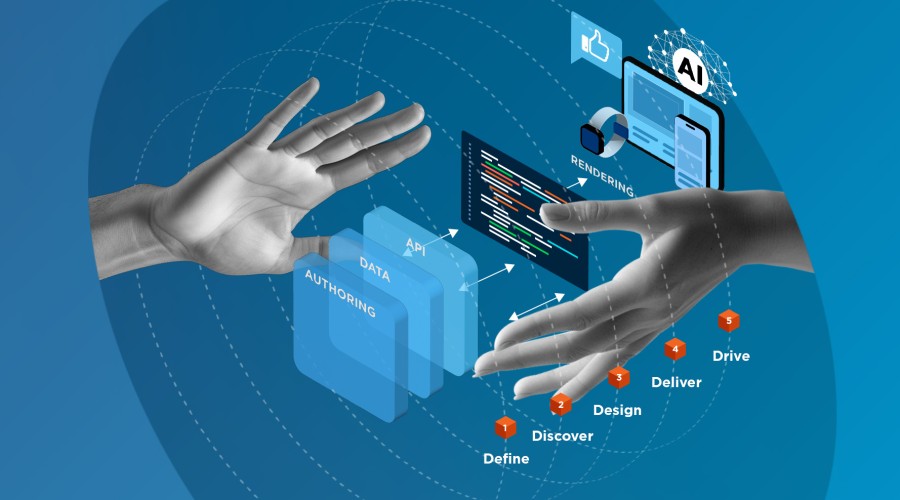Maintaining a future-proof, forward-looking content strategy isn't always easy. You need to be open to adapting your strategy to external elements and changes in society and technology, as well as having a clear internal plan that aligns your business on common themes and goals.
We recently ran the Future of Content Strategy: Accessible, Personalised, and SEO-Friendly webinar. Led by Senior UX Designer Tod Khanian, we invited three experts from our partners to explore key themes, topics and trends in this subject:
- Laura Devonald - Head of Client Services at Zest Digital
- Paul Crichton - Head of Accessibility and Digital Inclusion at Test Partners
- Camilla West - Digital Content Strategist at Scroll
Watch the highlights of the virtual webinar below or read on for our key insights.
Demystifying Content Strategy
We kicked off by asking, what is a content strategy? Simply put, your content strategy is what connects your business's content efforts with your goals, objectives and user needs. This will typically be documented, with guidelines that content creators should follow for web pages, blog posts and social media.
When getting started, you want to ensure that you have a clear plan of action.
Before you begin creating content, you need to know:
- Who you are, and what your position is within your industry
- Who you are trying to reach and why
- What you are trying to achieve
- How you will reach your audience and achieve your goals
We presented this process using a diamond framework that takes your business from Demystify to Define, Design and Develop.
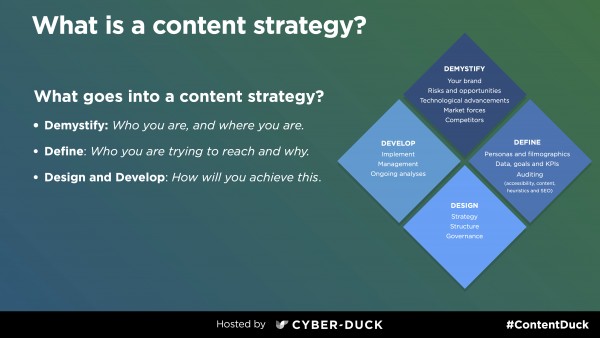
Performing a Content, Audience and UX Audit
The first talk for our Future of Content Strategy webinar was from Cyber-Duck Senior UX Designer Tod Khanian.
As Tod explained, businesses need to ensure that their audience can find what they’re looking for. Your goal is to produce user-centric content that is delightful and engaging. This is achieved by performing audience research and a content audit.
Start by asking yourself, 'Who is my ideal customer?'
If you're not 100% sure on this, then you need to perform in-depth audience research. Start by talking to stakeholders in your business, and carry out audience research through interviews, surveys and desktop research. B2B companies will also want to develop firmographic profiles – these are similar to personas, but tailored for B2B businesses and organisations.
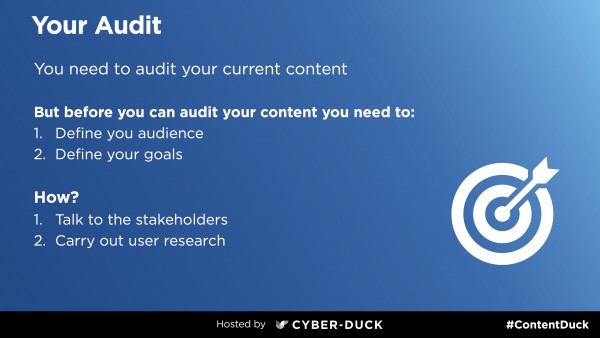
The next stage is the content audit. To perform this, you need to review every existing web page and blog post with the following criteria:
- Importance
- Analytics
- Content theme / type
- Quality of content
- User stories
- Persona groups
- Content potential – keep / delete / merge
As well as this, it is also recommended that you conduct a performance and data analysis – reviewing backlinks, PageSpeed data, Google Analytics and Search Console data. Tools such as Screaming Frog and URL Profiler can support in collating data for content audits.
Next, you need to establish your keyword strategy and KPIs.
SEO 101 and the Value of Content
Google's algorithm has transformed significantly over the last few years. More recently they have been putting a greater emphasis on site structure, user experience and site performance. Yet, keyword research has remained a core essential of SEO performance.
During her talk, Laura Devonald described the process of building an SEO strategy in the same way you build a house, with each component being integral to the structure.
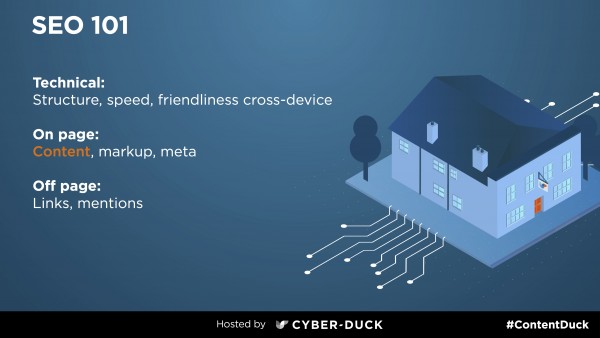
The keyword strategy is one of the most important components. So, it requires time and effort to develop. As Laura recommended, Google Keyword Planner can provide significant value here to:
- Establish how competitive target search terms are
- Discover additional keywords relevant to your business/content
- Review the average number of searches for target keywords
A properly defined keyword strategy will ensure that your site drives consistent, relevant traffic to your content and website from search engines. This will need to be tracked with the right web analytics tools and measured with KPIs in place.
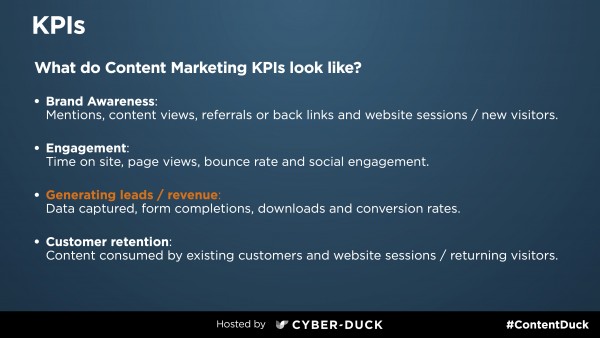
Keeping Accessibility in Mind
In the next talk, Paul Crichton explained why every business needs to consider accessibility in their future content strategy.
We now have a greater awareness of people living with various disabilities. Within the UK, around 22% of the population has some form of disability, such as a visual impairment, hearing loss, or a physical disability. Furthermore, people with cognitive difference or motor impairments can also face certain accessibility issues when accessing content online.
As Paul explained, organisations have business, legal and ethical responsibilities to ensure that their content is widely accessible.
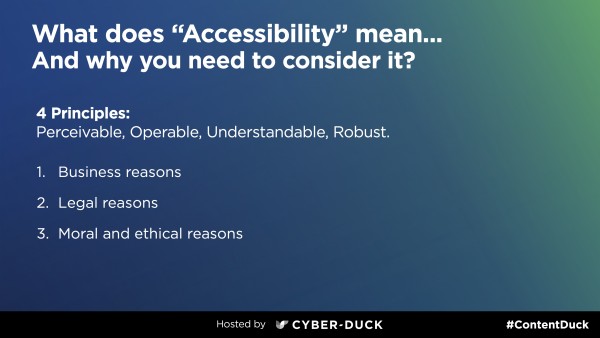
To help get people started, Paul recommended five simple accessibility tests:
-
Can you navigate and interact with a web page using only your keyboard?
-
Do all your pages have unique titles to help people distinguish between content?
-
Do all your forms have helpful error messages in case a user makes a mistake or skips a required field?
-
Do all your videos have accurate captions for people with hearing difficulties to use?
-
Are all the links on your website clear and obvious to different types of website visitors?
A Future-Proof Method to Structuring Content
In the fourth talk, Tod explored the role of information architecture (IA) and user experience principles in a content strategy.
As with every stage of the content strategy process, your IA and content mapping need to be intuitive and tailored to your users. Think about how users will be accessing content on your website. Ask yourself:
- Is the user journey obvious?
- Are there logical next steps?
- Is the content structured logically on web pages?
- Does the CMS provide me with the right functionalities?
- Is my website and content truly user-friendly?
These are essential questions to understanding how your audience will find and interact with different forms of content. Once you've answered these questions, you can begin exploring how to elevate their experience with automation and personalisation.
Your Publishing Strategy
The final talk was from Camilla West, Digital Content Strategist at Scroll, on Publishing Strategy.
Once you've defined your audience, set KPIs and established a UX and IA plan, you need to create a process for content production and publishing on an ongoing basis.
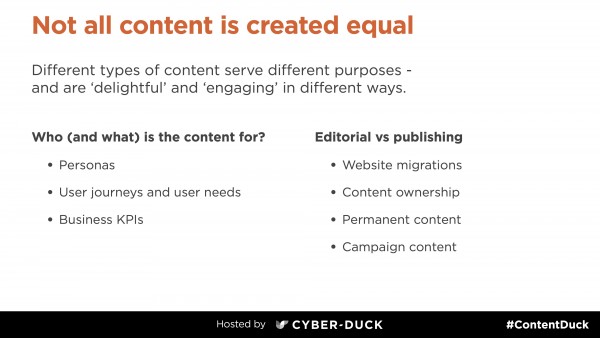
The content you create and publish should have a measurable benefit to your business. However, not all content is equal or serves the same purpose. For example, a long-form thought leadership article serves a different purpose to snackable information on a service page.
Your persona and user research will help you develop different types of content for different stages of the user journey. At each touchpoint, the content should be discoverable and enable your target audiences to complete their task. As Camilla explained, there should be acceptance criteria to measure this. For example, a user has:
- Signed up to the newsletter
- Submitted a contact form
- Made an enquiry
Many organisations don't measure this. In fact, many don't do the groundwork well, with the backbone of their strategy being weak. Having a clear content creation process and guidelines are essential to building a content strategy.
You can get started on enhancing your digital copy with our Content Optimisation Periodic Table.
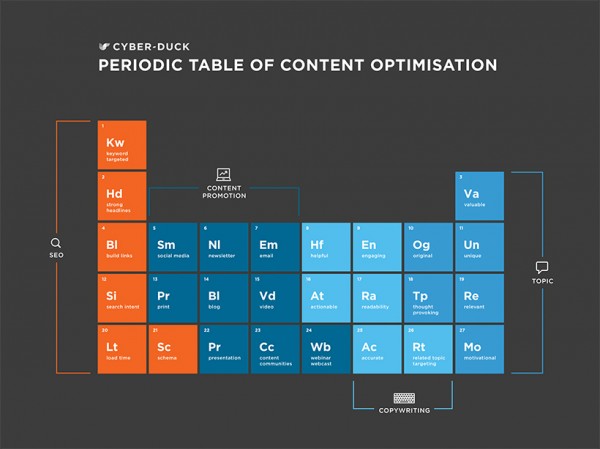
Conclusion
In many ways, the future of content strategy is doing the less obviously-exciting things well.
By being forward-looking and planning in advance, your content strategy will be more adaptable, dynamic and valuable. It will enable you to create more enriching content for your users, and enable you to better measure the success of your output.
View the slides from the webinar. If you would like access to the full webinar, please contact us at hello@cyber-duck.co.uk or via our contact page.
We're also available for a coffee (virtual or otherwise) to discuss any UX or content challenges your business may have, or to carry out a free UX audit.
